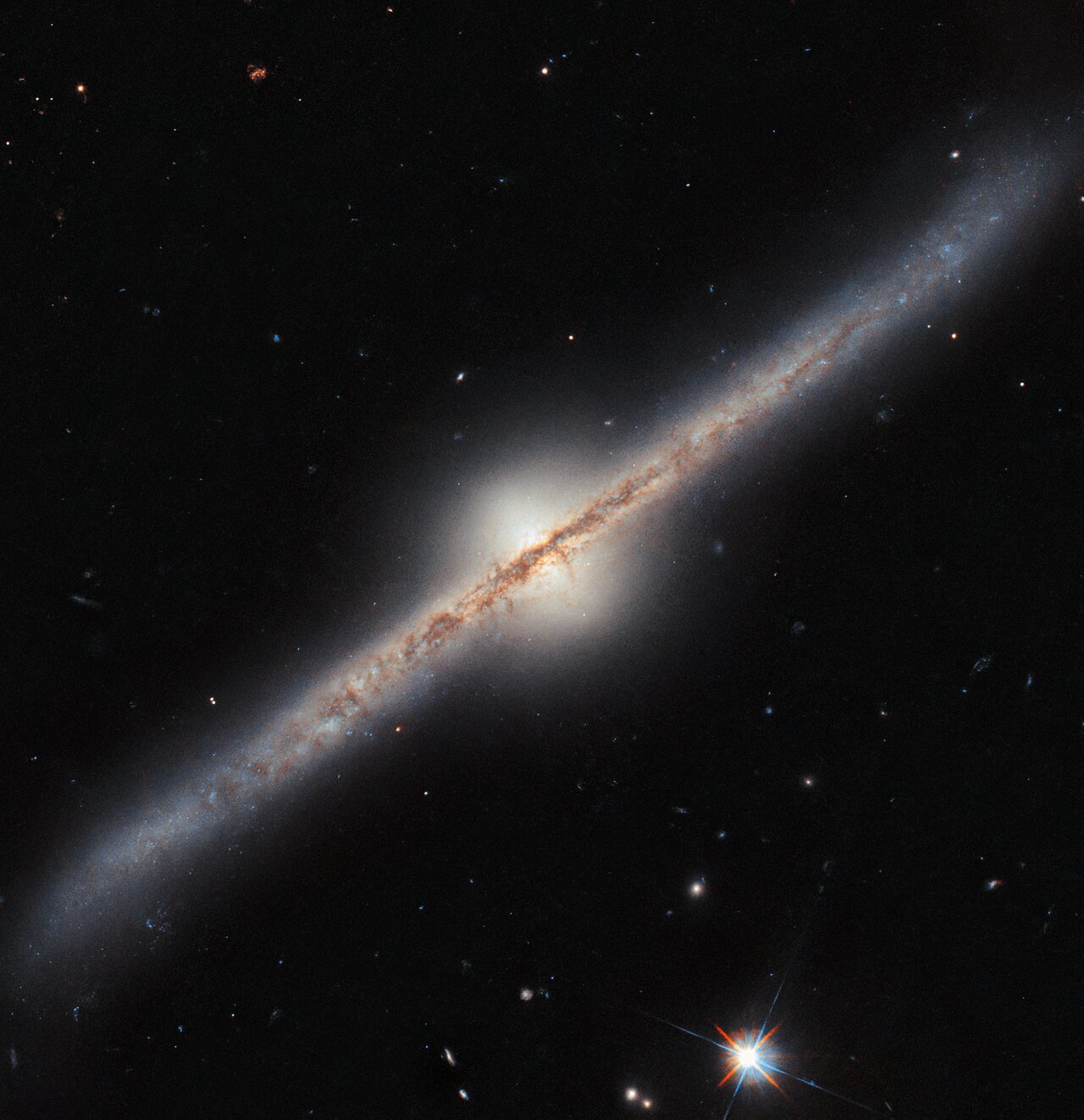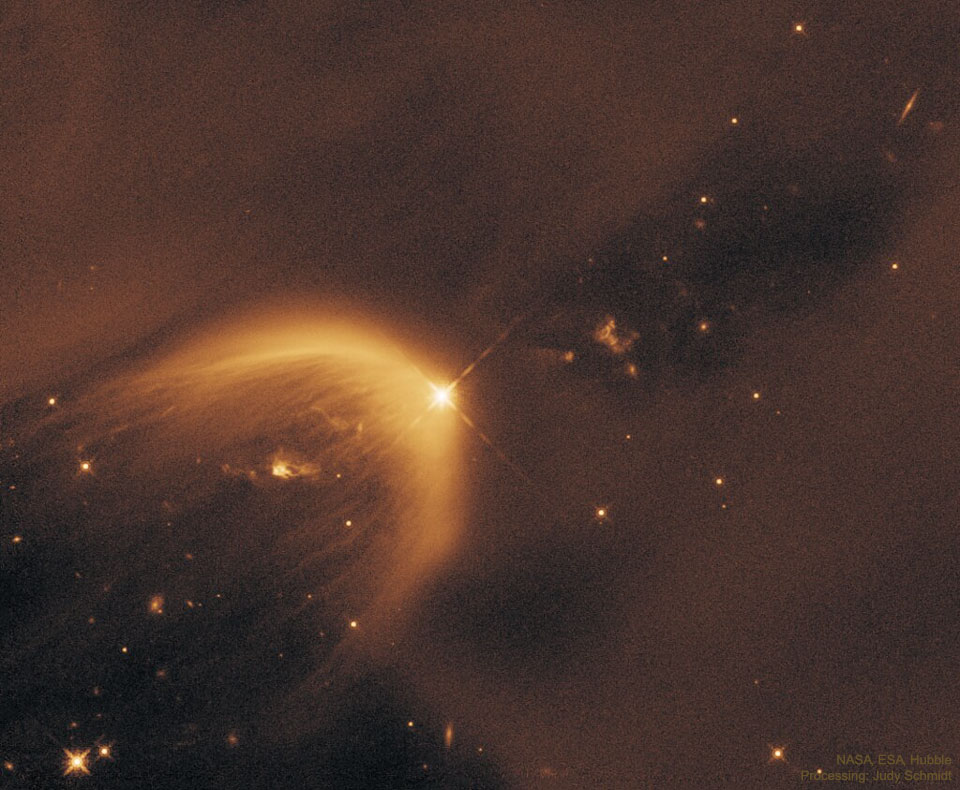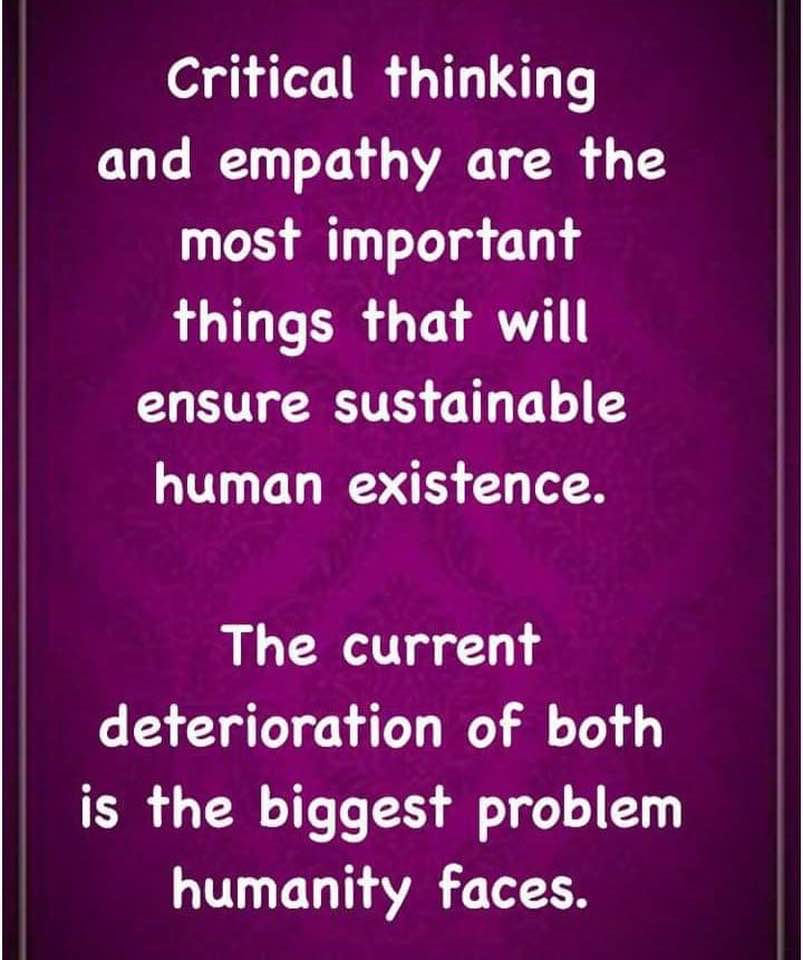Blog
What kind of astronomical object is this? It doesn’t look quite like the kinds of galaxies, nebulae, star clusters or galaxy clusters which Hubble normally brings us images of. In fact, this is a spiral galaxy, named UGC 10043 — we just happen to be seeing it directly from the side! Located roughly 150 million light-years from Earth in the constellation Serpens, UGC 10043 is one of the somewhat rare spiral galaxies that are seen edge-on.
From this point of view, we see the galaxy’s disc as a sharp line through space, overlain with a prominent dust lane. This dust is spread across the spiral arms of UGC 10043, but it looks very thick and cloudy when viewed from the side. You can even see the lights of some active star-forming regions in the arms, shining out from behind the dust. Strikingly, we can also see that the centre of the galaxy sports a glowing, almost egg-shaped ‘bulge’, rising far above and below the disc. All spiral galaxies have a bulge like this one as part of their structure, containing stars that orbit the galactic centre on paths above and below the whirling disc; it’s a feature that isn’t normally obvious in pictures of galaxies. The unusually large size of this bulge compared to the galaxy’s disc is possibly thanks to UGC 10043 siphoning material from a nearby dwarf galaxy. This may also be why the disc is warped, bending up at one end and down at the other.
Like most of the full-colour Hubble images released by ESA/Hubble, this image is a composite, made up of several individual snapshots taken by Hubble at different times and capturing different wavelengths of light. You can see the exact images used in the sidebar on this page. A notable aspect of this image is that the two sets of Hubble data used were collected 23 years apart, in 2000 and 2023! Hubble’s longevity doesn’t just afford us the ability to produce new and better images of old targets; it also provides a long-term archive of data which only becomes more and more useful to astronomers.
[Image Description: A spiral galaxy seen directly from the side, such that its disc looks like a narrow diagonal band across the image. A band of dark dust covers the disc in the centre most of the way out to the ends, and the disc glows around that. In the centre a whitish circle of light bulges out above and below the disc. The tips of the disc are a bit bent. The background is black and mostly empty.]

Ignacy Jan Paderewski (Polish. 18 November [O.S. 6 November] 1860 – 29 June 1941) was a Polish pianist, composer and statesman who was a spokesman for Polish independence. In 1919, he was the nation’s prime ministerand foreign minister during which he signed the Treaty of Versailles, which ended World War I.
A favorite of concert audiences around the world, his musical fame opened access to diplomacy and the media, as possibly did his status as a freemason, and charitable work of his second wife, Helena Paderewska. During World War I, Paderewski advocated an independent Poland, including by touring the United States, where he met with President Woodrow Wilson, who came to support the creation of an independent Poland in his Fourteen Points at the Paris Peace Conference in 1919, which led to the Treaty of Versailles.
Shortly after his resignation from office, Paderewski resumed his concert career to recoup his finances and rarely visited the politically chaotic Poland thereafter, the last time being in 1924.
more...
Cindy Blackman Santana (born November 18, 1959), sometimes known as Cindy Blackman, is an American jazz and rock drummer. Blackman has recorded several jazz albums as a bandleader and has performed with Pharoah Sanders, Sonny Simmons, Ron Carter, Sam Rivers, Cassandra Wilson, Angela Bofill, Buckethead, Bill Laswell, Lenny Kravitz, Joe Henderson and Joss Stone.
Blackman was born November 18, 1959, in Yellow Springs, Ohio. Her mother and grandmother were classical musicians and her uncle was a vibist. As a child, her mother took her to classical concerts.
Blackman’s introduction to the drums happened at the age of seven in Yellow Springs. At a pool party at a friend’s house. she saw a drum set and began playing them. “Just looking at them struck something in my core, and it was completely right from the second I saw them,” says Blackman. “And then, when I hit them, it was like, wow, that’s me.” Soon after, Blackman began playing in the school band and persuaded her parents to get her toy drums.
When Blackman was 11, she moved to Bristol, Connecticut, where she attended the Hartt School of Music in Hartford.Blackman began to have an interest in jazz at age 13 after listening to Max Roach and got her first professional drum set at 14.
Blackman then attended the Berklee College of Music in Boston, where she studied with Alan Dawson, who had also taught Tony Williams, an inspiration for Blackman. While she was at Berklee, a friend recommended her for a gig with The Drifters, so Blackman left college after three semesters and moved to New York City in 1982.
more...Donald Eugene Cherry (November 18, 1936 – October 19, 1995 Oklahoma City, OK) was an American jazz trumpeter, bandleader, and multi-instrumentalist. Beginning in the late 1950s, he had a long tenure performing in the bands of saxophonist Ornette Coleman, including on the pioneering free jazz albums The Shape of Jazz to Come (1959) and Free Jazz: A Collective Improvisation (1961). Cherry also collaborated separately with musicians including John Coltrane, Charlie Haden, Sun Ra, Ed Blackwell, the New York Contemporary Five, and Albert Ayler.
Cherry released his debut album as bandleader, Complete Communion, in 1966. In the 1970s, he became a pioneer in world music, with his work drawing on African, Middle Eastern, and Hindustani music. He was a member of the ECM group Codona, along with percussionist Naná Vasconcelos and sitar and tabla player Collin Walcott. Chris Kelsey of AllMusic called Cherry “one of the most influential jazz musicians of the late 20th century. Cherry died of liver cancer in Málaga, Spain, on October 19, 1995, at the age of 58.
more...Máximo Francisco Repilado Muñoz Telles (18 November 1907 – 13 July 2003), known professionally as “Compay Segundo“, was a Cuban trova guitarist, singer and composer.
Compay (meaning compadre) Segundo, so called because he was always second voice in his musical partnerships, was born in Siboney, Cuba, and moved to Santiago de Cuba at the age of nine. His first engagement was in the Municipal Band of Santiago de Cuba, directed by his teacher, Enrique Bueno. In 1934, after a spell in a quintet, he moved to Havana, where he also played the clarinet in CI the Municipal Band. He also learned to play the guitar and the tres, which became his usual instruments. Compay Segundo also invented the armónico, a seven-stringed guitar-like instrument, to fill the harmonic jump between the Spanish guitar and the tres. In the 1950s he became well known as the second voice and tres player in Los Compadres, a duo he formed with Lorenzo Hierrezuelo in 1947.
more...Jack Owens (November 17, 1904 – February 9, 1997) was an American blues singerand guitarist, from Bentonia, Mississippi.
more...Harold Eugene Clark (November 17, 1944 – May 24, 1991) was an American singer-songwriter and founding member of the folk rock band the Byrds. He was the Byrds’ principal songwriter between 1964 and early 1966, writing most of the band’s best-known originals from this period, including “I’ll Feel a Whole Lot Better“, “She Don’t Care About Time“, “Eight Miles High” and “Set You Free This Time“. Although he did not achieve commercial success as a solo artist, Clark was in the vanguard of popular music during much of his career, prefiguring developments in such disparate subgenres as psychedelic rock, baroque pop, newgrass, country rock, and alternative country. He was inducted into the Rock and Roll Hall of Fame in 1991 as a member of the Byrds.
more...This illuminated cavity, known as LDN 1471, was created by a newly forming star, seen as the bright source at the peak of the parabola. This protostar is experiencing a stellar outflow which is then interacting with the surrounding material in the Perseus Molecular Cloud, causing it to brighten. We see only one side of the cavity — the other side is hidden by dark dust. The parabolic shape is caused by the widening of the stellar-wind blown cavity over time. Two additional structures can also be seen either side of the protostar; these are known as Herbig-Haro objects, again caused by the interaction of the outflow with the surrounding material. What causes the striations on the cavity walls, though, remains unknown. The featured image was taken by NASA and ESA’s Hubble Space Telescope after an original detection by the Spitzer Space Telescope.

more...
Gordon Meredith Lightfoot Jr. CC OOnt (November 17, 1938 – May 1, 2023 Orillia, Ontario, Canada) was a Canadian singer-songwriter and guitarist who achieved international success in folk, folk-rock, and country music. Credited with helping to define the folk-pop sound of the 1960s and 1970s, he has been referred to as Canada’s greatest songwriter, having several gold and multi-platinum albums and songs covered by some of the world’s most renowned musical artists. Lightfoot’s biographer Nicholas Jennings said, “His name is synonymous with timeless songs about trains and shipwrecks, rivers and highways, lovers and loneliness.”
Lightfoot’s songs, including “For Lovin’ Me”, “Early Morning Rain“, “Steel Rail Blues”, “Ribbon of Darkness“—a number one hit on the U.S. country chart with Marty Robbins‘s cover in 1965—and “Black Day in July”, about the 1967 Detroit riot, brought him wide recognition in the 1960s. Canadian chart success with his own recordings began in 1962 with the No. 3 hit “(Remember Me) I’m the One”, followed by recognition and charting abroad in the 1970s. He topped the US Hot 100 or Adult Contemporary (AC) chart with the hits “If You Could Read My Mind” (1970), “Sundown” (1974); “Carefree Highway” (1974), “Rainy Day People” (1975), and “The Wreck of the Edmund Fitzgerald” (1976), and had many other hits that appeared in the top 40.
Robbie Robertson of the Band described Lightfoot as “a national treasure”. Bob Dylan, who would sometimes perform Lightfoot’s songs, said “I can’t think of any Gordon Lightfoot song I don’t like. Every time I hear a song of his, it’s like I wish it would last forever.” Lightfoot was a featured musical performer at the opening ceremonies of the 1988 Winter Olympic Games in Calgary, Alberta and received numerous honours and awards.
more...Imrat Khan (17 November 1935 – 22 November 2018) was an Indian sitar and surbahar player and composer. He was the younger brother of sitar maestro Ustad Vilayat Khan. Imrat Khan was born in Calcutta on 17 November 1935 into a family of musicians tracing its roots back for several generations, to the court musicians of the Mughalrulers. The training in music traditionally has been passed down from father to son for nearly 400 years. He belonged to Etawah gharana also known as Imdadkhani gharana of classical musicians. Imrat Khan’s father was Enayat Khan (1895–1938), recognised as a leading sitar and surbahar player of his time, as had been his grandfather, Imdad Khan (1848–1920), before him. Imrat Khan’s father died when Imrat was a child, so he was raised by his mother, Bashiran Begum and her father, singer Bande Hassan Khan. In 1944, the family moved with Vilayat Khan, Imrat’s older brother, to Bombay where both the brothers learned sitar-playing extensively from their uncle Wahid Khan. In 1952, Vilayat and Imrat moved in together in Calcutta. They performed together for many years. The two brothers were part of the first cultural delegation to the Soviet Union and Eastern Europe in 1956.
more...David Werner Amram III (born November 17, 1930) is an American composer, arranger, and conductor of orchestral, chamber, and choral works, many with jazz flavorings. He plays piano, French horn, Spanish guitar, and pennywhistle, and sings.
Amram was born in Philadelphia, the son of legal scholar Philip Werner Amram. He studied at the Oberlin Conservatory of Music in 1948–1949, and earned a bachelor’s degree in European history from George Washington University in 1952. In 1955 he enrolled at the Manhattan School of Music, where he studied under Dimitri Mitropoulos, Vittorio Giannini, and Gunther Schuller. Under Schuller he studied French horn. As a sideman or leader, Amram has worked with Aaron Copland, Thelonious Monk, Dizzy Gillespie, Charles Mingus, Jack Kerouac, Sonny Rollins, Lionel Hampton, Stan Getz, George Barrow, Jerry Dodgion, Paquito D’Rivera, Pepper Adams, Arturo Sandoval, Oscar Pettiford, Allen Ginsberg, Mary Lou Williams, Kenny Dorham, Ray Barretto, Wynton Marsalis, and others. He has also worked with a wide range of folk, pop, and country figures, such as Bob Dylan, the Roche sisters, Pete Seeger, Odetta, Willie Nelson, Oscar Brand, Judy Collins, Peter Yarrow, Tom Paxton, Phil Ochs, Josh White, Patti Smith, Arlo Guthrie, and others.
more...- b. 17 November 1911, Gumwood, Arkansas, USA, d. 17 January 1985, Sikeston, Missouri, USA. De Berry was an active if peripheral member of the Memphis blues community from its heyday during the 20s until the early 50s. He grew up in Arkansas and Mississippi before moving to Memphis to live with his aunt in 1927. Teaching himself to play ukulele and then banjo and guitar, he associated with the likes of Will Shade, Charlie Burse, Jack Kelly, Frank Stokes and a very young Walter Horton. While in East St. Louis in 1934, he lost the lower part of his right leg in a train accident. Five years later, he recorded for Vocalion Records with his Memphis Playboys in a style that updated the hokum music from the earlier part of the decade. Over the next 15 years De Berry spent time in St. Louis and Jackson, Tennessee, returning to Memphis to make radio appearances with Willie Nix and Walter Horton. In 1953 he recorded two sessions for Sun Records; at the first session, he and Horton recorded the classic ‘Easy’, an instrumental adaptation of Ivory Joe Hunter’s ‘I Almost Lost My Mind’. The blues ballad ‘Time Has Made A Change’, with accompaniment from pianist Mose Vinson, came from the second session. In 1972 producer Steve LaVere reunited De Berry and Horton for sessions designed to recreate their earlier partnership, an endeavor that met with little success.
More Posts
- Joe Morello Day
- Vince Guaraldi Day
- Flamenco Fridays with Cameron y Tomatito
- Daily Roots with Bob Marley
- Music for Surviving the Pandemic and Realizing Racial Justice
- The Cosmos with the Great Attractor
- Desmond Decker Day
- Rubén Blades Dia
- Nat Pierce Day
- Cal Tjader Day
- Bola Sete Day
- World Music with Pokošovci
- Daily Roots with Stephen Marley
- Music for Surviving the Pandemic and Realizing Racial Justice
- The Cosmos with the South Pole Wall
- Joe Satriani Day
- Linda Ronstadt Day
- Julian Bream Day
- Philly Joe Jones Day
- Sadik Hakim Day


